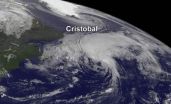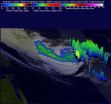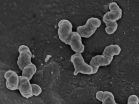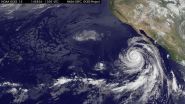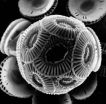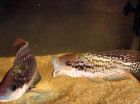(Press-News.org) Satellite imagery shows Hurricane Cristobal racing through the North Atlantic on Friday, August 29 while losing its tropical characteristics. An image from NOAA's GOES-East satellite showed Cristobal headed south of Greenland. The previous day, NASA's TRMM satellite saw heavy rainfall occurring in the hurricane.
In a visible image from NOAA's GOES-East satellite on August 29 at 7:45 a.m. EDT, Hurricane Cristobal was moving through the North Atlantic about 500 miles southwest of Greenland. The image was created by the NASA/NOAA GOES Project at NASA's Goddard Space Flight Center in Greenbelt, Maryland.
At 5 a.m. EDT (0900 UTC) on August 29, Cristobal's maximum sustained winds were near 80 mph (130 kph). The National Hurricane Center forecast noted that Cristobal is forecast to lose its tropical characteristics later today, but it should remain a powerful extra0tropical cyclone over the North Atlantic through Sunday, August 31.
The center of Hurricane Cristobal was located near latitude 42.1 north and longitude 51.7 west. Cristobal was moving toward the northeast near 49 mph (80 kph) and is expected to continue in that direction while slowing down. The estimated minimum central pressure is 973 millibars.
The TRMM Satellite Sees Heavy Rainfall in Cristobal
On the previous day, NASA and the Japan Aerospace Exploration Agency's Tropical Rainfall Measuring Mission (TRMM) satellite had a very good view of Cristobal on August 28 at 12:58 UTC (8:58 a.m. EDT) as the hurricane passed well to the northwest of Bermuda.
At NASA Goddard, rainfall data derived from TRMM's Microwave Imager (TMI) and Precipitation Radar (PR) data was overlaid on a visible/infrared image from NOAA's GOES-East satellite taken August 28 at 1300 UTC (9 a.m. EDT). TRMM PR found some intense thunderstorms producing rain at a rate of almost 78 mm (about 3.1 inches) per hour in a band of precipitation feeding into Cristobal's southeastern side.
The TRMM satellite was close to reaching its northern most coverage when the satellite flew over on August 28, 2014. TRMM covers the tropics, and Cristobal was moving out of range when TRMM captured data on it. The GPM satellite launched by NASA and JAXA on Feb. 27, 2014 will continue viewing hurricane Cristobal as the tropical cyclone moves farther north over the open waters of Atlantic Ocean.
Headed to the United Kingdom
The U.K. Meteorological Service (UKMS) forecast for Cristobal calls for the storm to move northeast across the Atlantic toward Iceland, staying well away from the U.K. The UKMS noted that Cristobal could bring stronger winds across northwestern parts of Scotland and rain across the United Kingdom on Sunday, August 31 and Monday, September 1.
INFORMATION:
Text credit: Rob Gutro
NASA's Goddard Space Flight Center
NASA sees Hurricane Cristobal racing through North Atlantic
2014-08-29
ELSE PRESS RELEASES FROM THIS DATE:
CCNY team defines new biodiversity metric
2014-08-29
To understand how the repeated climatic shifts over the last 120,000 years may have influenced today's patterns of genetic diversity, a team of researchers led by City College of New York biologist Dr. Ana Carnaval developed a new biodiversity metric called "phylogeographic endemism."
It quantifies the degree to which the genetic variation within species is restricted in geographical space.
Dr. Carnaval, an assistant professor of biology, and 14 other researchers from institutions in Brazil, Australia and the United States, analyzed the effects of current and past climatic ...
Hydrogen powers important nitrogen-transforming bacteria
2014-08-29
This news release is available in German. Nitrite-oxidizing bacteria are key players in the natural nitrogen cycle on Earth and in biological wastewater treatment plants. For decades, these specialist bacteria were thought to depend on nitrite as their source of energy. An international team of scientists led by Holger Daims, a microbiologist at the University of Vienna, has now shown that nitrite-oxidizing bacteria can use hydrogen as an alternative source of energy. The oxidation of hydrogen with oxygen enables their growth independent of nitrite and a lifestyle outside ...
NASA animation shows Hurricane Marie winding down
2014-08-29
VIDEO:
This video of NOAA's GOES-West satellite imagery from Aug. 26-29 shows Hurricane Marie winding down into a post-tropical storm.
Click here for more information.
NOAA's GOES-West satellite keeps a continuous eye on the Eastern Pacific and has been covering Hurricane Marie since birth. NASA's GOES Project uses NOAA data and creates animations and did so to show the end of Hurricane Marie.
At 5 a.m. EDT (0900 UTC) on Friday, August 29, Marie became a post-tropical storm ...
'Face time' for the heart diagnoses cardiac disease
2014-08-29
To the careful observer, a person's face has long provided insight into what is going on beneath the surface. Now, with the assistance of a web camera and software algorithms, the face can also reveal whether or not an individual is experiencing atrial fibrillation, a treatable but potentially dangerous heart condition.
A pilot project, the results of which were published online today in the journal Heart Rhythm, demonstrates that subtle changes in skin color can be used to detect the uneven blood flow caused by atrial fibrillation. The technology was developed in a ...
Not all phytoplankton in the ocean need to take their vitamins
2014-08-29
Some species of marine phytoplankton, such as the prolific bloomer Emiliania huxleyi, can grow without consuming vitamin B1 (thiamine), researchers have discovered. The finding contradicts the common view that E. huxleyi and many other eukaryotic microbes depend on scarce supplies of thiamine in the ocean to survive.
"It's a really different way to think about the ocean," says CIFAR Senior Fellow Alexandra Worden, co-author on The ISME Journal paper with CIFAR fellows John Archibald (Dalhousie University), Adrián Reyes-Prieto (University of New Brunswick) and three lead ...
Ready for mating at the right time
2014-08-29
This news release is available in German. The exchange of chemical signals between organisms is considered the oldest form of communication. Acting as messenger molecules, pheromones regulate social interactions between conspecifics, for example, the sexual attraction between males and females. Fish rely on pheromones to trigger social responses and to coordinate reproductive behavior in males and females. Scientists at the Marine Science Center at the University of the Algarve in Faro, Portugal, and at the Max Planck Institute for Chemical Ecology in Jena, Germany, ...
China's reform of R&D budget management doesn't go far enough
2014-08-29
In almost 20 years, China's R&D expenditure as a percentage of its gross domestic product has more than tripled, reaching 1.98 per cent in 2012. This figure surpasses the 28 member states of the EU, which collectively managed 1.96 per cent.
However, despite this, China saw a sharp decline in money spent on scientific research, in particular applied research. Basic research funding plummeted from 5.2 per cent in 1995 to 4.7 per cent in 2011, and applied research funding fell from 26.4 per cent to 11.8 per cent in the same years.
This is Dr Cao's second Science article ...
Snails tell of the rise and fall of the Tibetan Plateau
2014-08-29
Boulder, Colo., USA - The rise of the Tibetan plateau -- the largest topographic anomaly above sea level on Earth -- is important for both its profound effect on climate and its reflection of continental dynamics. In this study published in GSA Bulletin, Katharine Huntington and colleagues employ a cutting-edge geochemical tool -- "clumped" isotope thermometry -- using modern and fossil snail shells to investigate the uplift history of the Zhada basin in southwestern Tibet.
Views range widely on the timing of surface uplift of the Tibetan Plateau to its current high ...
Science advice to governments comes of age at Auckland conference
2014-08-29
Auckland, New Zealand (29 August) — Science advice to governments has emerged as a discipline in its own right, which is both art and science. This is what delegates to the world's first summit of science advice heard at a meeting in Auckland, which closed today with a strong call to strengthen international collaboration, an agreement to formalise the network and meet again in 2016.
Convened by the International Council for Science (ICSU) and hosted by New Zealand's Chief Science Advisor, Sir Peter Gluckman, this historic summit marks a turning point in the global awareness ...
Intervention needed for survivors of childhood burns
2014-08-29
Adults who have been hospitalized for a burn as a child experience higher than usual rates of depression and suicidal thoughts, according to new research at the University of Adelaide.
A 30-year follow up of childhood burns victims has been conducted by the University's Centre for Traumatic Stress Studies. They found that 42% of people surveyed had suffered some form of mental illness and 30% suffered depression at some stage in their lives.
The results, now published in the journal Burns, also found that long-term depression was an issue among the group, and 11% had ...
